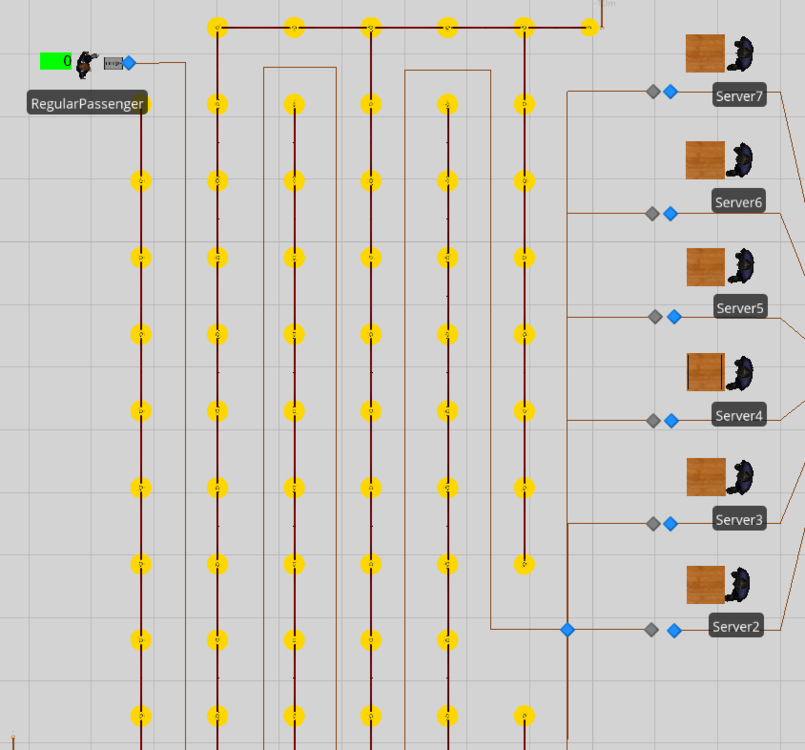Search the Community
Showing results for 'sink percentage of entities'.
-
Hello, I am building a model which consists out of hundreds of different entities. Instead of creating hundreds of sources, I am seeking to release all entities out of one single source according to individual entity specific distributions. I have seen examples which specify a product mix table and interarrival times but this would not capture the simultaneous release of the entities. I would appreciate, if someone could point me towards a smart approach. Thanks!
-
Thanks Hurol! The "problem" with that property is that this only serves to process one additional entity. In my case, there can be n>=1 entities and I need to process all of them.
-
The Combiner object in the standard library assumes that you have a parent entity representing a box or container and members representing the parts that are combined into the parent. In some cases you don't want to have a parent, you just have a number of entities that you want to temporarily join together and process as one. The attached project contains an object of type Node that represents a very simple Combiner and a TestModel to illustrate how it works. The node simply asks for a Batch Size and then holds the incoming entities until that batch size is reached. It creates a "normal" batch so it can be used with the Separator as long as you treat all outbound entities as the same. CombinerNode.spfx Requires Sprint 5.80 or later.
-
Greetings, I am building a model which requires 20 entities to arrive at the first hour then four hours of break with no arrivals . Then repeat the same pattern of arrival of 20 for one hour and four hours break in between. I have been using the arrival schedule and use the rate of 20 in the first hour and 0 in the next four hours . However I am not getting 20 entities exactly with this arrival schedule and it is always less than 20. Is there away to force the exact number of entities arriving per hour? Thanks M Alseiari
-
Thank you so much for your help. In your sample, entities choose the sink based on the sink's capacity. Which one has the lowest capacity entity is sent to that sink. In my problem, I put counter on each sink. All entities are sent to that sink until the desired value is obtained for that sink then entities go to the second sink, so on so forth. Could you please help about this problem? Thanks, Nadere
-
Hello, I have a network that it has several sources and sinks. I set the following properties for each path: 1) Initial Traveler Capacity: 770000 2) Drown to scale: False 3) Logical Length: 150 Miles 4) Allow Passing: False 5) Speed Limit: 90 Miles per Hour. By putting these properties on the link, congestion is occurred in the system. When I run the model that entities randomly choose path and sink, TimeInSystem get different values for minimum, maximum and average in result part. However, when I put sequence for all paths and source, TimeInSystem get the same values for minimum, maximum and average in result part while we have congestion in the network. Can you tell me why the TimeInSystem does not change? Thanks, Nadere
-
I am using transfer step for the entities to the sink but there are different links and path between the source and sink. So, if I use transfer step in add on process, the entity transfer from source to sink directly. Then, the time in system cannot be computed. I want to determine the destination (sink) by using add on process after checking some criteria. Could you please help me about this problem? My goal is to choose the sink after checking some criteria and then send entities from source to that destination(sink) by using some path randomly. Thanks, Nadere
-
No, it seems your add-on process is working correctly. How do you transfer the entities to the sink? It seems there is not time advancement between creation and disposing the entities.
-
I'm dealing with a similar situation with my model. I'm trying to tell my model to seize 1 resource object for every 3 entities. How can I go about this?
-
Hi Jason, If you just want to see the emissions for each Entity traveling through your Model, you could attach a Status Label to each Entity type displaying the TotalDistanceTraveled, or some calculation including it like TotalDistanceTraveled*0.323. To attach it just click on the Entity instance in Interactive mode and then draw the Status Label near it. Or you could define State Variables like Ship_Dist, Truck_Dist, Train_Dist to keep track of total distance traveled for all Entities of each type. You would then define State Assignments at their final destination (Sink), or some Node along their path, to increment with NewValue of "Ship_Dist + ModelEntity.TotalDistanceTraveled" then compute the total emissions for each type at the end of the run. Note that you would need an Assign If 'Custom Condition' like 'ModelEntity.Is.ShipEntity' for this to work. Happy modeling, Adam
- 1 reply
-
- totaldistancetraveled
- distance
- (and 5 more)
-
Record Statistics Per Entity Throughout Simulation
Emiliano posted a topic in SI General Discussions
Hi! I have been using SIMIO for quite some time now, but I have barely come across this need. I need to record the time spent per entity at any given path/server in the simulation, rather than obtaining the average time for all entities at the end of the simulation. Take the image below as an example. I need to record the time spent in the link (TimeOnLink) per entity generated. The path corresponds to that connecting the source to servers 2-7. Then, I need to record the time spent per entity on servers 2-7 (TimeInStation). I can display the unique ID number for each entity by Entity.ID, now I need to match the statistics. I figure the best way to model is trough ExcelWrite, but I can't manage to make it work. Any hints? The plan is to get the following information per entity, rather than a summary of all entities.- 1 reply
-
- excelwrite
- entity
-
(and 1 more)
Tagged with:
-
Released entities in a vehicle's visit request queue
cstein posted a topic in SI General Discussions
Hi, I would like to confirm whether behaviour regarding vehicle visit request queues is incorrect (i.e. a bug) or whether I am misunderstanding how they are supposed to work. I have two types of vehicles in an Emergency Medical Services model. One type transports patient entities (i.e. an ambulance) and one doe not do transport but only responds to some incidents (i.e. a primary response vehicle or PRV). In some cases, both vehicles are sent to an incident node, the ambulance by accepting a visit request from a patient entity at the node, and the PRV by being seized directly by the patient entity at the node. In some cases the PRV is far away and does not reach the node by the time the ambulance has completed loading the patient entity. In such cases I have modelled cancelling of the PRV (that would happen in a real system) by the patient entity releasing the PRV. When this happens, I have noticed that the patient entity that had seized the PRV stays in the PRV's visit request queue, even after the release. It is only removed from the visit request queue when the patient entity is destroyed, which may be some time later after a transport and hospital offload delay. From observing the behaviour of other vehicles, it seems as though a vehicle must enter a node having the owner entity in it before the entity is removed from the visit request queue (or, as mentioned above, it is removed when the entity is destroyed). In my case, I would like to remove the patient entity from the PRV's visit request queue when the PRV is released, however I know that this is not possible as Simio does not allow entities to be removed from this queue with the remove step. At the moment I am spending a lot of time trying to work around this problem, which creates a lot of undesirable behaviour - for example when there are three or four patient entities in the PRV's visit request queue. The vehicle object also has limited options in its task selection strategy which makes filtering out of the released entities in the visit request queue difficult to accomplish reliably. Is there any other way of removing unwanted entities from the visit request queue, without visiting that entity's node or destroying it? -
Hi All, In examining a medical system, we have a requirement to log snapshots of the patient details being processed at specific points in time during experiment replications. For each server, we would like to know the state values for entities currently in processing in each functional area ( a mix of servers and storage queues). I suppose I am looking for an "Easy Button" which would quickly capture a Work In Process snapshot of the system. Are there any thoughts on accomplishing something like this? Any kind comments would be greatly appreciated. Thanks, Jim
-
Hi Jim, May be there are many possible ways to follow to get the information you want. But, I suggest you to use a search step for searching a server's (or any other object's) processing queue to get such information. You can search not only the server's processing queue but also the whole "entity population" to get whole state variable's defined on them at any arbitrary time thoughout the simulation run. All you have to do is to define additional expressions on search step. In the example file attached a simple model is developed to get entities' state variables residing at server1's processing queue. Here note that, you have to click button at arbitrary times. Then, if 3 or more entities exist at server1.processing queue, the search step founds the first 3 of them (since a forward search is performedin this sample model) then later an excel write step writes entities created time (you can get many state variables of entities written on the same excel file). You can change search limit, queue state name, include a match condition etc. If you want to get such information at the beginning or at the end of the simulation run you should use this same logic at appropriate processes (onrunending, onruninitialized etc...). Also, you can get these information written on either a database or an output table as well. Hope this helps? getting a snaphot of Entity WIP via a button.spfx entities_processing.xlsx
-
Hi Gocken, Thank you for your kind and quick response! I really like this use of a button! Unfortunately, I was not clear enough. As entities move through the system they carry quite a lot of state information. Our desire is at end or replication or an arbitrary time like a button click which a neat idea, to take an inventory of all the entities AND their states. This would mean capturing all the entities in each processing queue and through a write step. writing them out, either to an output table or a CSV. This operation is a bit complex. It does not seem one can search a processing queue to sequentially write out its members properties. I believe it is possible to maintain the residence of servers by maintaining that in a special output table which is tedious to maintain and set up. I greatly appreciate your response! Best Regards, Jim
-
Blocking a server through a waiting room
Sebastian Vicencio posted a topic in SI General Discussions
Hello! I need to block a specific server in my model, preventing this server from starting its the processing time. The conditions for this to happen are dictated by the following servers, according to a number. In this simplified model I made, if the entity went through the server M1, then this server will stay suspended until T4 finished its processing time. At the same time, M2 will have the same behavior. Following the above, the server just before M1 and M2, called Volvo, must not start its processing time if M1 and M2 are working or if either one is working while the other one has suspended its processing time due to T4 is working with the entity just went through. The thing is I already tried 2 approaches, the first one was through suspending the server called Volvo (Bloqueo volvo file), and resuming when T4 finished its processing time, but despites it is suspending Volvo's processing time, it doesn't resume it correctly. On the other hand, I tried using a waiting room that blocks the pass of entities trying to reach the Volvo server, but it works erratically (Bloqueo volvo cancha file). I would appreciate any suggestion or help of any kind. Thanks in advance. bloqueo volvo.spfx bloqueo volvo cancha.spfx -
Hi I want to calculate at certain moment of a simulation the number of entities crossing an area of the facility window. With this calculation I would get a value such as etities/area. how can i do it?
-
Hi Everyone, I have 100s of different products in a warehouse and I want to get statistics for all of them such as distance travelled, number entered and exited. So I created the entity instances for each product automatically through data table. The entity.totaldistancetraveled function doesnt increase since the entity doesnt moveby itself but moved by forklift instead. So I have created a state variable called "distanceonforklift" and increased by the difference between the forklift total distance travelled value when entity exits and enters to forklift. I have also created a function called "distancefunction" on the entity and equated it to "distanceonforklift" state variable of the entity. For the return type of function I have chosen "number" and set the unit to "length". I validated that both distance state variable and function is calculated correctly in the facility window. However I cannot output the result of this state variable on the model results screen. I used the following expression under model outputstatistic but it didnt work. "ProductA.DistanceFunction". That expression gives me 0 value although there are some entities of this product which enters and exits the system. How can I see the average total distance travelled on forklift for the whole population of Product A?
-

Entity Distance travelled on Transporter
ttarkan replied to ttarkan's topic in SI General Discussions
Thanks you so much for you help Liz. That's such an advanced modeling techinique I had never heard of before. I would never be able to figure it out myself. It has almost worked but correctly. It has recorded the results for some tallies correctly but recorded some tallies on the wrong tally. I think there is a problem with the set row feature somewhere. I have no problem with setting rows elsewhere in the model such as arrivals from production and arrivals from truck tables create entities correctly with all their state variables. The product list table also has unique "productnames" (entity instances), set as key and auto set-row property is set to true. I have added another coloumn with element tally statistics reference (DistanceOnForklift) to products table. I have auto created it as you suggested and turned on the auto-set row feature to true. Both my product names and tally statistics coloumn are set as key in same "products" table. But the tally step still doesnt record them to the correct tally statistics. Where am I doing wrong? Would you still be able to help me? Shall I send you the model in private message? Here is the formula I have inputted 'Products[Products.ProductName.RowForKey(ModelEntity.EntityType.Name)].DistanceOnForklift' and in the picture below you can see that tally step records into wrong tally element on last three entries. I would be glad if you could help me. -
Hi Guys, I have a source producing the entities, which is processed by the server with a worker. server and worker are assigned to work schedule (7Hrs) (12am-7am) arrival model of the server is set to time varying arrival rate. to control the source on holidays. But with current scenario the source is producing the entities on off-shift time. Please help out with a logic, so that source is produces the entities matching to the timings of work schedule. Note: Simulation run is for a period of 1 year. Regards, Alen
-
Good day, I am using Simio for my final year project and was hoping to get some advice with regard to transporting entities with multiple vehicles. At each transfer node one can only specify the transporter type as “Specific” or “From list”. I therefore created a list containing the specific vehicles needed to transport the entities. I have tried numerous methods but failed to assign the vehicles to specific entities once the entities are created. I therefore need to use a certain property of a created entity as a decision basis for assigning the entity to a certain vehicle once it is created. Hope you can help . Kind Regards, Rhynard
-
Basically, I want to know how SIMIO creates the time between entity arrivals. Does SIMIO create all the times at once or the program does it dynamically (one at a time)? My problem is that I'm using the Arrival mode "Time Varying Arrival Rate" and for every day of simulation I want to change the "rate scale factor". If I do this with a state variable it doesn't work. For explample, if on day 1 I have a rate scale factor equal to 1 and on day 2 it's equal to 100, in day 2 the times between arrivals don't change at all.
-
Entity Distance travelled on Transporter
Liz Millar replied to ttarkan's topic in SI General Discussions
I would recommend using a Data Table. One column could have all your entity types defined. The next column could be a Tally Statistic Element Reference Property. This column would match up the Tally statistic you want to correspond with the Entity Type. You could choose to auto-create these Tally Statistics from the Data Table. If you change the Tally Statistic Property's column Reference Type property from 'Reference' to 'Create', this will make the Tally Statistics for you. I recommend the Help page "Table-Based Elements (Auto-Create)" in Simio for more information. If your Entity Instances noted in the Data Table are unique, no duplicates, you can set that column as a Key. With that column as a Key, you could use just the Tally step and use the RowForKey expression. RowForKey will allow a key input to search for in that column. If the model entity is driving the process, you could use an expression like this for the Tally Statistic Name 'Table1[Table1.EntityInstanceProperty1.RowForKey(ModelEntityReference)].TallyStatisticProperty'. Since it seems this process will be on the OnRunEnding, it will not have a reference to a specific entity, so you will most likely need a Search step to find the entities still in the system. I would set the Search step to find Infinite things and let each entity reference exit on the found branch. If the EntityInstanceProperty column in your Data Table has the Auto-set Table Row Reference property to 'True', the entities will already know the row reference and your Tally step Tally Statistic Name property could be 'Table1.TallyStatisticProperty'.








